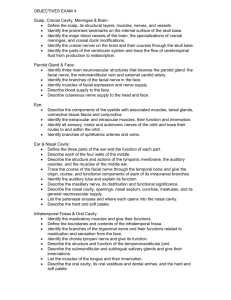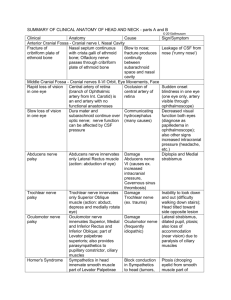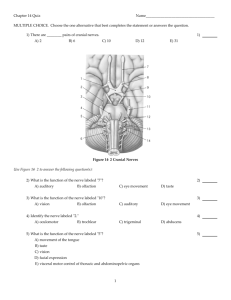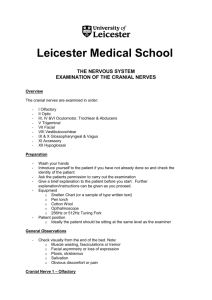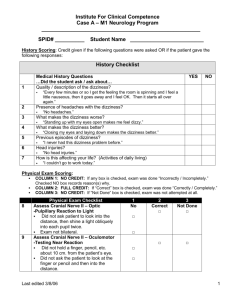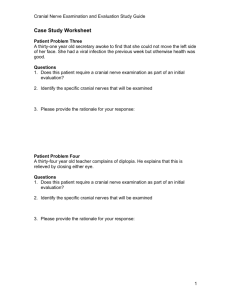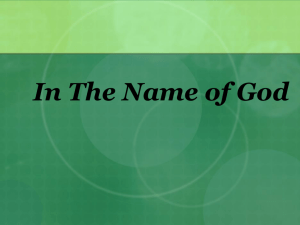Branchial arches
advertisement
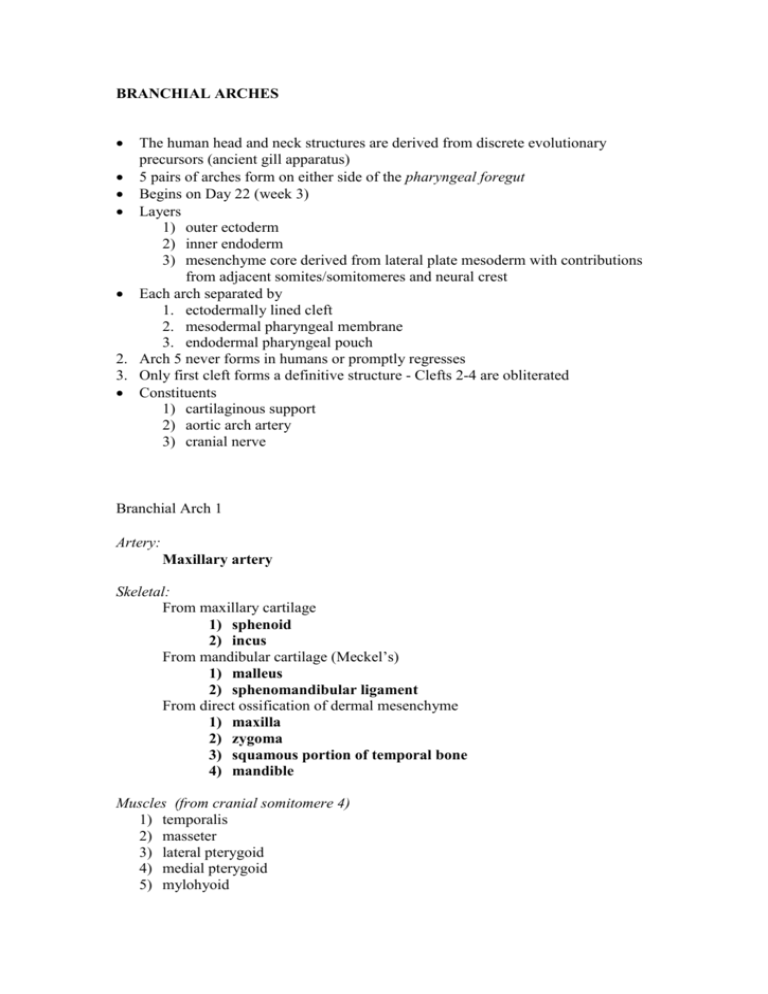
BRANCHIAL ARCHES The human head and neck structures are derived from discrete evolutionary precursors (ancient gill apparatus) 5 pairs of arches form on either side of the pharyngeal foregut Begins on Day 22 (week 3) Layers 1) outer ectoderm 2) inner endoderm 3) mesenchyme core derived from lateral plate mesoderm with contributions from adjacent somites/somitomeres and neural crest Each arch separated by 1. ectodermally lined cleft 2. mesodermal pharyngeal membrane 3. endodermal pharyngeal pouch 2. Arch 5 never forms in humans or promptly regresses 3. Only first cleft forms a definitive structure - Clefts 2-4 are obliterated Constituents 1) cartilaginous support 2) aortic arch artery 3) cranial nerve Branchial Arch 1 Artery: Maxillary artery Skeletal: From maxillary cartilage 1) sphenoid 2) incus From mandibular cartilage (Meckel’s) 1) malleus 2) sphenomandibular ligament From direct ossification of dermal mesenchyme 1) maxilla 2) zygoma 3) squamous portion of temporal bone 4) mandible Muscles (from cranial somitomere 4) 1) temporalis 2) masseter 3) lateral pterygoid 4) medial pterygoid 5) mylohyoid 6) anterior belly digastric 7) tensor tympani 8) tensor palate Cranial Nerve 1) Maxillary and mandibular divisions of trigeminal nerve Pouch 1) Tubotympanic recess – tympanic cavity and Eustachian tube 2) Anterior 2/3rd tongue 1st Branchial cyst Located inferior or ventral to external acoustic meatus May drain thru a cervical aural fistula which usually opens into the EAM Branchial Arch 2 Artery: Stapedial artery Skeletal – Reichert’s cartilage 1) Stapes 2) Styloid process 3) Hyoid bone – lesser horn and superior rim of body 4) Stylohyoid ligament Muscles (from cranial somitomere 6) 1) Muscles of facial expression 2) Posterior belly digastric 3) Fronto-occipitalis 4) Stylohyoid 5) Stapedius Cranial Nerve 1) Facial nerve Cleft 1) External acoustic meatus Pouch 1) Palatine tonsils 2) Copula tongue (overgrown) 2nd Branchial cyst Located just ventral to the ventral border of sternomastoid May have external and/or internal fistula Internal fistula travels through carotid bifurcation to open into palatine tonsils Branchial Arch 3 Artery: Common carotid artery Skeletal 1) Hyoid – greater horn and inferior rim of body Muscles (from cranial somitomere 7) 1) stylopharyngeus Cranial Nerve 1) Glossopharngeal nerve Pouch 1) thymus gland 2) inferior parathyroid glands Branchial Arch 4 Artery: Arch Aorta Skeletal 1) Laryngeal cartilages Muscles (from occipital somites 2-4) 1) Pharyngeal constrictors 2) Cricothyroid 3) Levator veli palatini Cranial Nerve 1) Superior laryngeal branch of Vagus nerve Pouch 1) Superior parathyroid glands Branchial Arch 6 Artery: Ductus arteriosus Skeletal 1) Laryngeal cartilages Muscles (from occipital somites 1-2) 1) Intrinsic muscles larynx Cranial Nerve 2) recurrent laryngeal branch of Vagus nerve Pouch Ultimobranchial bodies – differentiate into C cells (parafollicular) of thyroid – produce calcitonin Origins of craniofacial muscles Mesodermal Origin Somitomeres 1, 2 Somitomere 3 Somitomere 4 Somitomere 5 Somitomere 6 Somitomere 7 Somites 1, 2 Somites 2-5 Muscles Superior, medial and ventral recti Superior oblique Muscles of mastication Lateral rectus 2nd arch muscles Stylopharyngeus Intrinsic laryngeals Tongue muscles Innervation CN III CN IV CN V CN VI CN VII CN IX CN X CN XII


